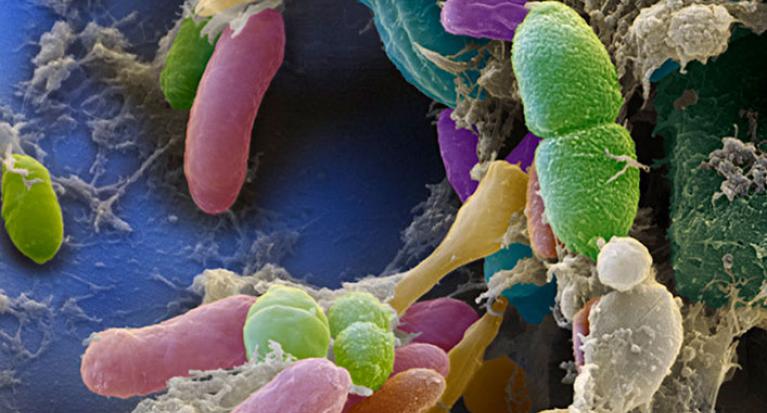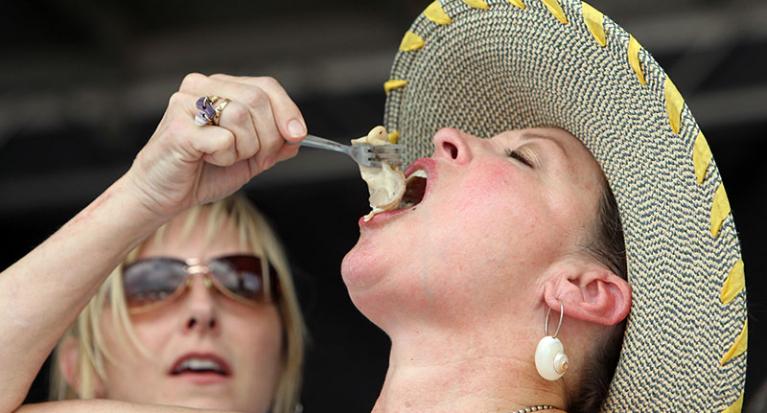Appetite as a cinematic metaphor
A review of famous food scenes in French cinema.
“Loss of appetite is a dreadful blight!” Quand l'appétit va, tout va! So goes the song sung in unison by Asterix and Obelix in the 1968 animated film Asterix and Cleopatra(1), as the two famous Gallic heroes revel happily in a dreamlike scene featuring roasted boar and enormous slices of cake. This is a classic positive portrayal of a healthy appetite, designed to be both invigorating and heart-warming at the same time. Food-loving characters in films are often likeable too, invariably associated with bons vivants ready to take a bite out life, devour a book or swallow difficulties. Take the example of the colourful character Gérard, played by Eddy Mitchell in the film Le Bonheur est dans le Pré by Etienne Chatiliez.(2) When accused by his friend Francis of thinking only about what he wants to eat, he replies happily: “What can I say? I'm a simple guy! I appreciate the basic things in life!”
In contrast to these lovers of life, who “embody appetite” and “inspire”, as Vincent Chenille notes in his book on gastronomic enjoyment in film(3), how do we perceive characters suffering from lack of appetite or nausea? With suspicion, it seems, as evidenced once again in Le bonheur est dans le pré by Gérard’s tirade directed at Nicole, a woman with a lack of appetite and perceived to be a killjoy, during a dinner scene at a restaurant: “We don’t order broccoli steamed with Vittel water here; we order things we enjoy. Enjoy! You do know this word, don’t you?” This portrayal of a lack of appetite is thus linked to an inability to enjoy oneself, while Nicole’s character symbolises “the drama of the digestive system, which conveys gloominess, emotion and fear through its organs...”(4)
In this legendary scene from Le bonheur est dans le pré by Etienne Chatiliez (1995), Gérard (Eddy Mitchell) forces Nicole (Sabine Azéma), who usually nibbles at “shrimp and flower salads” while following thalassotherapy spa treatments, to find pleasure in eating. D.R.
"/>
In Alain Resnais’ film On connaît la chanson (1997), Camille (Agnès Jaoui) suffers from nausea and vertigo. Her family tend to her and try to get her to eat a banana. D.R.
Lack of appetite and melancholy
In Peau d’Âne(5) by Jacques Demy, the charming prince embodies the figure of the depressed young man who regrets not being able to find love. During a rural banquet in the first part of the film, we witness the prince slumped at the table in a typical state of melancholy, his chin resting on his hand:
- You have not eaten a thing, your Royal Highness...
- I’m not hungry.
- Is something missing? Or someone, perhaps?
- I was just thinking about the world and its peculiarities.
Once the prince finally discovers Peau d’Âne (Donkeyhide) dressed as a princess, he falls madly in love. Not able to have her, he goes three days without eating. The prince tells his father that he will eat nothing other than a cake baked by the hand of his sweetheart. The ‘love cake’ – a symbol of the prince’s feelings – is delivered to the prince and he devours it greedily. The insatiable hunger of this foolhardy romantic only confirms what the doctors had advised when he was not eating: “The prince is dying of love.” Following this excess of food, the prince falls asleep and dreams that he is walking hand-in-hand with Peau d’Âne in the countryside. We see the couple eating heartily at a country buffet, swearing their love to one another and promising to “gorge themselves on cakes”, an appetising metaphor for their life together.
Refusing to eat and family secrets
According to the director Bertrand Tavernier, “It is at mealtimes that we tell each other the important things.”(6)Eating scenes are used frequently, with only a few exceptions − François Truffaut, for example, couldn’t bear someone talking to him about food. As Nathalie Héron recalls, “the relationship between characters and food always reveals more than is shown, allowing the viewer the freedom of imagination. When we eat, it’s not just to satisfy a basic need, it’s also an expression of desire, which humanises our connection with food and spurs us on in life.”(7) So what does refusal to eat in these scenes signify?
In La vie est un long fleuve tranquille(8), beneath a subtle comedy of manners, Etienne Chatiliez depicts the harsh reality of a conflicted identity. Bernadette, daughter of the Le Quesnoys, a middle-class, Catholic family, learns at the age of 12 that she was swapped at birth with a baby boy and in fact belongs to the Groseille family, stereotypically portrayed as lower class.
Meals take on added significance in the Le Quesnoy household as they symbolise moments of education.(9) During one particular meal, a silent Bernadette slowly tips her bowl of soup onto the white tablecloth, to signal to her ‘adoptive’ parents that she is aware of the situation. In the deathly silence that follows, the soup flows across the table and the parents look at each other, speechless. While “the time and space of a meal are also to be considered as a fundamental structure of identity”(10), we might also remind ourselves that “up until the 18th century, the word nourriture (nourishment) also meant éducation (education) and the verb nourrir (to feed) could mean élever (to raise).(11) In this respect, the soup that spreads across the table can be seen to call into question the nourishing role of the Le Quesnoys and, at the same time, their identity as parents. The spilled soup speaks on behalf of Bernadette and seems to be saying: “I’m not part of your family. You won’t feed me any more.” Thick and greenish, the soup almost resembles vomit. It becomes language, while the child remains mute. If passer à table (to spill the beans) means to own up to something in informal French, the refused food in this scene becomes a resounding symbol of unspeakable situations.
Food as medicine for the soul
Lack of appetite and intense hunger (Peau d’Âne), hunger strikes and middle-class meals (La Vie est un long fleuve tranquille) – indicate that the metaphor of food only appears to be truly expressed in the form of contrasts and the solution to woe appears to reside in regaining one’s appetite.
In Le Bonheur est dans le Pré, Francis, played by Michel Serrault, is happy when he is eating and eats because he is happy. By contrast, he is at his lowest when he has lost his appetite. Hence, when Gérard visits Francis in hospital after experiencing fainting attacks and unveils a covered plate of kidneys and a bottle of Bordeaux wine with the words “Abracadabra!”, Francis regains some colour and begins laughing, as if by magic. Towards the end of the film, following another stress-related illness, he is again restored, this time by a glass of brandy: “That’s life. This is fire! It could revive a dead man!” Food therefore becomes medicine for the soul and eating synonymous with resurrection.
All quotes are an approximation of the original French audio.
(1) Astérix et Cléopâtre, René Goscinny and Albert Uderzo, Belgium, 1968, animated film, 72 mins
(2) Le bonheur est dans le pré, Etienne Chatiliez, with Michel Serrault, Eddy Mitchell, Sabine Azéma, Carmen Maura, France, 1995, comedy, 106 mins
(3) Chenille Vincent, Le plaisir gastronomique au cinéma, Jean-Paul Rocher Editeur, Paris, 2004, p.26.
(4) Durif-Bruckert Christine, La nourriture et nous : corps imaginaire et normes sociales, Paris, Armand Colin, 2007, p.78.
(5) Peau d’Âne, Jacques Demy, with Catherine Deneuve, Francis Perrin, Jean Marais, Delphine Seyrig, France, 1970, musical/fairytale, 89 mins.
(6) Ibid, p. 8.
(7) Héron Nathalie, « Les repas au cinéma : ordre et désordres à table », Christus, n°238, April 2013, p.1.
(8) La vie est un long fleuve tranquille, Etienne Chatiliez, with Benoît Magimel, Hélène Vincent, Catherine Jacob, France, 1988, comedy of manners, 90 mins
(9) In another meal scene, the father of the Le Quesnoy family explains to his youngest daughter in a wise manner: “Emmanuelle, having a cold drink after your hot soup will damage the enamel of your teeth. ”
(10) Durif-Bruckert Christine, «Corps, corporéité et rapport à l'aliment dans les troubles du comportement alimentaire», Champ psy 1/ 2003 (n°29), p.69.
(11) Héron Nathalie, op.cit., p.2.
DOSSIER Bon Appétit |
| The Yin and Yang of Hunger | |
| Appetite as a cinematic metaphor | |
| Microscopic guests | |
| The crazy world of competitive eating | |
| All dossiers | |
Objects
Addressing the issue of hunger in film
In contrast to the Christian value of temperance,...



